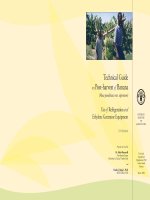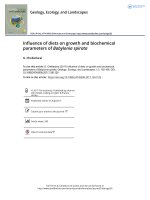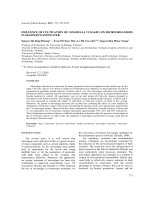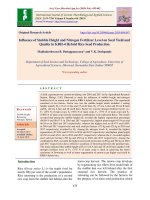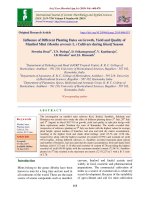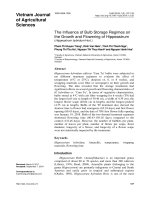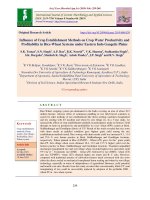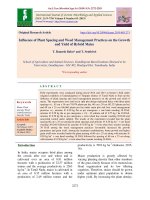Influence of packaging materials on quality of banana burfi during storage
Bạn đang xem bản rút gọn của tài liệu. Xem và tải ngay bản đầy đủ của tài liệu tại đây (440.4 KB, 10 trang )
Int.J.Curr.Microbiol.App.Sci (2017) 6(7): 118-127
International Journal of Current Microbiology and Applied Sciences
ISSN: 2319-7706 Volume 6 Number 7 (2017) pp. 118-127
Journal homepage:
Original Research Article
/>
Influence of Packaging Materials on Quality of Banana Burfi during Storage
Venkata Satish Kuchi1*, J. Kabir2, F.K. Bouri3, Rajesh Gupta4 and R.S. Dhua2
1
Department of Postharvest Technology, College of Horticulture, Dr. YSRHU,
Anantharajupeta, Andhra Pradesh-516105, India
2
Department of Postharvest Technology, 3Department of Fruits and Orchard Management,
BCKV, Nadia, West Bengal 741252, India
4
Scientist, Krishi Vigyan Kendra, RVSKVV, Gwalior, Madhya Pradesh-458001, India
*Corresponding author
ABSTRACT
Keywords
Ambient
condition, Burfi,
Low temperature,
Microbial load,
Packaging
materials.
Article Info
Accepted:
04 June 2017
Available Online:
10 July 2017
The present study was carried out in the department of Postharvest Technology of
Horticultural Crops, Bidhan Chandra Krishi Viswavidyalaya Mohanpur, Nadia, West
Bengal during 2012-2015. Preparation of banana burfi was standardized in the laboratory
by varying proportions of milk, sugar and banana pulp. It was found that 15% banana
pulp+ 30% sugar + 55% milk preferred by the taste panel constituted in the Faculty of
Horticulture. Burfi was packed in different packaging materials i.e., Aluminium foil (P1),
butter paper (P2) and polyethylene film (P3) and stored in ambient conditions (29±3 °C and
68-81% Relative Humidity (RH)) i.e., T1 and low temperature conditions (5±1 °C and 8590% RH) i.e., T2. Burfi packed in aluminium foil at low temperature (T 2P1) recorded
higher score for all sensory parameters (colour: 8.1; flavour: 8.5; texture: 8.5 and overall
acceptability: 8.3) followed by T 2P3 (Low temperature with polyethylene film) and T 2P2
(Low temperature with butter paper). The influence of packaging materials and storage
conditions on microbial count revealed that total bacterial count and yeast and mould count
were least in T2P1 (Low temperature + Aluminium foil) followed by T 2P3 (Low
temperature + polyethylene) and T 2P1 (Low temperature + butter paper) on 5th day of
storage. Burfi samples stored at ambient condition irrespective of packaging material
deteriorated faster due to high microbial count and not available after 5 days of storage.
Burfi samples packed in aluminium foil retained moisture and could be stored for 15 days
at low temperature with low microbial load and high consumer acceptability.
Introduction
iron. The ripe fruits are delicious and are used
for table purpose. Many products are made
from banana such as banana chips, fig, soft
drink, flour and jam. Banana flour is prepared
from unripe fruits and banana powder from
ripe fruits.
Banana is one of the oldest fruits known to
mankind. It is one of the widely grown and
consumed fruits due to their distinct aroma
and taste, in all parts of the world. It is highly
nutritive and every part of the plant is useful.
For these reasons it is often referred as „Apple
of Paradise‟ and „Tree of paradise‟. It is a
good source of vitamin A, C and B2. Fruits are
rich source of minerals like magnesium,
sodium, potassium, phosphorous, calcium and
India is the largest producer of banana in the
world. In West Bengal, banana is cultivated in
an area of 45,500 ha with a production of 1.09
118
Int.J.Curr.Microbiol.App.Sci (2017) 6(7): 118-127
million tonnes for the year 2013-14
(Anonymous,
2015).
Moreover,
with
increasing population and urbanization
leading to conversion of agricultural land in to
industrial areas it is hardly possible to make
an increase in area under cultivation. Instead,
if we minimize the post-harvest losses,
automatically there will be increase in
production. However, this high production
will have significance only when it reaches
consumers in good condition.
preferred by the taste panel constituted in the
Faculty of Horticulture.
Procurement of banana fruits
Banana fruits cultivar „Martaman‟ were
procured from the farm maintained by AICRP
on Tropical fruits, Mandoli, Nadia district.
Hands were ripened at room temperature.
Healthy, unblemished fruits were selected for
the preparation of burfi. Peeled fruits were
washed and cleaned, and the pulp was
extracted manually. It was homogenized in a
deluxe pulper (mixer) machine to obtain fine
pulp.
Faulty handling practices coupled with
underdeveloped and exploitive marketing
systems results in postharvest losses to the
extent of about 30% and value deterioration,
leaving little quality surpluses for export and
processing (Anonymous, 2002).
Banana burfi preparation
Banana burfi was prepared as per the
procedure laid down by Sachdeva and
Rajorhia (1982), with slight modification.
Buffalo milk standardized to 6% fat and 15%
total solids was concentrated in a stainless
steel pan by open pan boiling with continuous
stirring and scraping until a semi-solid mass
of paste-like consistency was obtained. Sugar
@ 30% of khoa was added to sweeten the
product. When the product showed a tendency
to form compact mass, the temperature was
lowered to 88–90 °C and selected levels of
banana pulp (15 %) was added. Finally, this
mixture was heated on a low fire with gentle
stirring till the desired consistency of banana
burfi was obtained. Just before the finish
point potassium sorbate @ 0.2% was added
which acts as preservative. It was then spread
uniformly in a tray with ghee and allowed to
cool. After setting, banana burfi was cut into
blocks of 25×25×25 mm. Later, burfi was
packed in different packing materials (Figure
3) and studied for quality attributes under
ambient conditions (29±3 °C and 68-81%
RH) and low temperature conditions (5±1 °C
and 85-90% RH). The details of treatments
were presented in table 1.
In Nadia district of West Bengal most of the
banana produced is consumed in fresh form.
Thus processing of banana into value added
products will reduce post-harvest losses and
add value to it. People in this region are fond
of sweets. Innovative products like banana
burfi will gain prominence in this region. The
shelf life of burfi can be further increased by
using suitable packing material. It will also
help small scale industries and provide
employment to rural youth and women.
Therefore, keeping these points in view a plan
of research programme on “Influence of
packaging materials on quality of burfi during
storage” was undertaken.
Materials and Methods
The present study was carried out in the
department of Postharvest Technology of
Horticultural Crops, Bidhan Chandra Krishi
Viswavidyalaya Mohanpur, Nadia, West
Bengal during 2012-2015. Preparation of
banana burfi was standardized in the
laboratory by varying proportions of milk,
sugar and banana pulp. It was found that 15%
banana pulp+ 30% sugar + 55% milk
119
Int.J.Curr.Microbiol.App.Sci (2017) 6(7): 118-127
Coliforms in the samples were estimated by
plating appropriate dilutions (10− 2) on Violet
Red Bile Agar (VRBA) before being
incubated at 37 °C for 24 h (Jain et al., 2015
and Abdalla and Ahmed, 2010).
Details of observations
Burfi packed and stored in ambient and low
temperature conditions were studied for
quality parameters such as moisture content,
microbial count and sensory analysis.
Statistical design
Sensory analysis
The data obtained from four replications were
subjected to the analysis of variance by „F‟
test for two factor Factorial Completely
Randomized Design (Gomez and Gomez,
1984).
A total of 15 male and female panellists were
selected and trained for scoring. Each
panellist was first briefed with the important
sensory evaluation conceptual knowledge.
Each panellist received and evaluated the
same amount of duplicate coded sample chips
in a controlled sensory evaluation laboratory
with separate boxes for each panellist. The
samples were evaluated on the basis of their
texture, flavour, colour and overall
acceptability. Furthermore, all panellists
given scores for the samples for each quality
feature using a hedonic scoring scale of 1 to 9
on the provided evaluation sheet according to
Gupta (1976) given in table 2.
Results and Discussion
The treatment which performed best in
experiment “Standardization of banana burfi
making and quality assessment” i.e. T6 (15%
banana pulp + 30% sugar + 55% Milk) was
taken in this experiment to study the effect of
packaging materials on quality of burfi under
different storage conditions.
The quality of burfi standardized with 15%
banana pulp + 30% sugar + 55% Milk is
presented in table 3. The colour, flavour
texture and overall acceptability of the
prepared burfi were recorded 8.8, 8.5, 8.5 and
8.6 respectively. The effect of storage
condition on the sensory quality of burfi has
been depicted in table 4. In general it has been
found that the burfi stored at T2 (Low
temperature) was found superior to T1
(Ambient condition) and colour, flavour,
texture and overall acceptability of T2
remained significantly higher (i.e. 8.0, 8.3, 8.3
and 8.2 respectively) than T1 (6.9, 6.9, 6.8 and
6.9 respectively) on 5th day of storage.
Although sensory score for packaging with
aluminium foil (P1) was higher than that of
polyethylene film (P1), the score for colour,
flavour, texture and overall acceptability of
both the treatments i.e. P1 (Aluminium foil)
and P3 (Polyethylene film) were at par.
Interaction effect of packaging and storage
Moisture content
The moisture content was determined by
taking 10 g of sample and dried in an oven at
65±2 °C to constant weight. The moisture
content in banana burfi samples was analyzed
using the AOAC (2000) method.
Microbial analysis
All the samples were subjected to total plate
count (TPC) for bacteria, yeast and mold
count (YMC) and coliform count. The TPC
was determined by surface spreading the
homogenate (prepared by macerating the burfi
samples in mortar and pestle) with 10−2
dilutions on plate count agar (PCA) and
incubated at 37 °C for 24 h. For mould and
yeast detection, appropriate dilutions (10−2)
of sample was spread on potato dextrose agar
(PDA) and incubated at 25 °C for 24 h.
120
Int.J.Curr.Microbiol.App.Sci (2017) 6(7): 118-127
condition on 5th day of storage revealed that
sensory score for texture was significant
(P≤0.05), while colour, flavour and overall
acceptability were non-significant (P≤0.05).
The interaction effect of T2P1 (Low
temperature storage and aluminium foil)
recorded higher score for all sensory
parameters followed by T2P3 (Low
temperature storage and polyethylene film)
and T2P2 (Low temperature storage and butter
paper).
statistically analysed (Table 5). No coliforms
were detected in any of the samples. Total
bacterial count and yeast and mould count
significantly (P<0.05) higher (9.42 log10
CFU/g and 8.84 log10 CFU/g) in the samples
stored in T1 (ambient conditions) than T2
(Low temperature conditions). However, the
samples stored in P1 (Aluminium foil) were
found to be containing significantly low (4.60
log10 CFU/g and 2.28 log10 CFU/g) total
bacterial count and yeast and mould count
than P3 (Polyethylene film) and P2 (butter
paper). Interaction effect showed that total
bacterial count and yeast and mould count
were least (2.45 log10 CFU/g and 1.41 log10
CFU/g) in T2P1 (low temperature storage and
aluminium foil) followed by T2P3 (Low
temperature storage and polyethylene film)
and T2P1 (Low temperature storage and butter
paper). While at ambient condition T1P2
(Ambient condition and butter paper) and
T1P3 total bacterial count (Figure 5) and yeast
and mould count were significantly high.
Highest counts (12.55 log10 CFU/g and 13.76
log10 CFU/g) for bacterial and mould and
yeast were observed in T1P2 (Ambient
condition and butter paper). As a result of
high microbial count burfi kept in ambient
conditions was not suitable beyond 5th day but
burfi samples kept in low temperature
conditions could be stored for 15 days.
Sensory scores for T1P1 were least. Burfi
samples kept at ambient conditions (29±3 °C
and 68-81% RH) were not available after 5
days of storage for further evaluation.
Initial moisture content of burfi was recorded
14.81% (Table 5). On the 5th day of storage
there was a slight decrease in moisture
content of burfi samples stored at ambient
conditions (29±3 °C and 68-81% RH) and
low temperature conditions (5±1 °C and 8590% RH) except in treatment combination
T2P1 (Low temperature storage and
aluminium foil) where it remained the same
(Table 4).
In general, at ambient condition (T1),
moisture content reduced significantly
(P≤0.05) in comparison to low temperature
(T2). In butter paper package moisture content
was significantly lower than P1 (Aluminium
foil) and P3 (Polyethylene film) on 5th day of
storage. Although P1 (Aluminium foil)
retained higher moisture content treatment P1
and P3 were at par. On 5th day, interaction
effect of temperature and package revealed
that moisture content was least in T1P2
(Ambient condition and butter paper) and
maximum in T2P1 (Low temperature storage
and aluminium foil).
Sensory data of low temperature at 10 and 15
days of storage is shown in bar diagram
(Figure 1). Colour, flavor, texture and overall
acceptability of T2P1 (Low temperature
storage and aluminium foil) was high (8.00)
on 10th day of storage followed by T2P3 (Low
temperature storage and polyethylene film)
and T2P2 (Low temperature storage and butter
paper). On 15th day also the trend of sensory
quality was similar, only the score was less
than 10 days. The sensory score of T2P2 (Low
temperature storage and butter paper) for
colour,
flavor,
texture
and
overall
acceptability was appreciably low.
Regarding influence of packaging materials
and storage conditions on microbial count of
banana burfi on 5th day of storage were
121
Int.J.Curr.Microbiol.App.Sci (2017) 6(7): 118-127
Table.1 Details of the treatments
Storage conditions
Ambient conditions (T1)
Low temperature (T2)
Packing materials
Aluminium foil (11µ) (P1)
Butter paper (P2)
LDPE (100 guage) (P3)
Aluminium foil (11µ) (P1)
Butter paper (P2)
LDPE (100 guage) (P3)
Treatment symbol
T1P1
T1P2
T1P3
T2P1
T2P2
T2P3
Table.2 Score acceptability for panellists
Score
9
8
7
6
5
4
3
2
1
Acceptability
Extremely desirable
Very much desirable
Moderately desirable
Slightly desirable
Neither desirable nor undesirable
Slightly undesirable
Moderately undesirable
Very much undesirable
Extremely undesirable
Table.3 Sensory quality and moisture content of fresh burfi
Sensory quality
Colour
Flavour
Texture
Overall acceptability
Moisture content
Mean score
8.8
8.5
8.5
8.6
14.81%
Table.4 Effect of packaging and storage condition on sensory quality of burfi on 5th day
Treatments
Colour
Flavour
6.9
6.9
T1
8.0
8.3
T2
0.13
0.09
SEm
0.40
0.25
CD0.05
7.5
7.9
P1
7.3
7.3
P2
7.5
7.7
P3
0.16
0.10
SEm
NS
0.31
CD0.05
7.0
7.3
T1P1
6.7
6.4
T1P2
6.9
7.1
T1P3
8.1
8.5
T2P1
8.0
8.1
T2P2
8.1
8.3
T2P3
0.23
0.15
SEm
NS
NS
CD0.05
T1: Ambient temperature, T2: Low temperature storage
P1: Aluminium Foil, P2: Butter paper, P3: Polyethylene Film
122
Texture
6.8
8.3
0.05
0.14
7.8
7.1
7.7
0.06
0.17
7.2
6.2
7.1
8.5
8.1
8.3
0.08
0.24
Overall acceptability
6.9
8.2
0.06
0.19
7.8
7.2
7.6
0.08
0.23
7.2
6.4
7.0
8.3
8.1
8.2
0.11
NS
Int.J.Curr.Microbiol.App.Sci (2017) 6(7): 118-127
Table.5 Effect of packaging and storage condition on moisture content (%) and
Microbial count of burfi on 5th day of storage
Treatments
T1
T2
SEm
CD0.05
P1
P2
P3
SEm
CD0.05
T1P1
T1P2
T1P3
T2P1
T2P2
T2P3
SEm
CD0.05
Moisture
content (%)
13.88
14.77
0.06
0.17
14.44
14.16
14.38
0.07
0.21
14.13
13.56
13.96
14.81
14.75
14.77
0.10
0.30
Total bacterial count
(log10 CFU/g)
9.42
3.18
0.17
0.50
4.60
8.35
5.95
0.21
0.61
6.75
12.55
8.95
2.45
4.15
2.95
0.29
0.87
Total mould and yeast
count (log10 CFU/g)
8.84
3.46
0.06
0.18
2.28
9.79
6.38
0.07
0.22
3.15
13.76
9.63
1.41
5.83
3.14
0.11
0.31
T1: Ambient temperature T2: Low temperature storage, P1: Aluminium Foil, P2: Butter paper, P3: Polyethylene Film
CFU: Colony forming units
Fig.1 Effect of packaging on sensory quality of burfi on 10th and
15th day of storage at low temperature
123
Int.J.Curr.Microbiol.App.Sci (2017) 6(7): 118-127
Fig.2 Effect of packaging on moisture content (%) of burfi on 10th and
15th day at low temperature storage
Fig.3 Packaging of burfi
Fig.4 Burfi samples after 15 days of storage under low temperature
124
Int.J.Curr.Microbiol.App.Sci (2017) 6(7): 118-127
Fig.5 Total plate count of bacteria on 5th day of storage
Moisture content at low temperature of T2P1
(Low temperature storage and aluminium
foil), T2P2 (Low temperature storage and
butter paper) and T2P3 (Low temperature
storage and polyethylene film) on 10th and
15th day as shown in figure 2 indicated that
T2P1 possessed least moisture both at 10th and
15th day followed by T2P3 and T2P2 in that
increasing order.
2012) resulting in darker burfi colour (Chawla
et al., 2013). The banana burfi packaged in
aluminium foil and stored at low temperature
were acceptable upto 15 days as shown from
superior colour, flavour, texture and overall
acceptability table 4 and figure 4. Low
moisture content of T2P1 treatment on 15th day
was because of low water vapour
transmission rate of aluminium foil when
compared to other packing materials. This
was the reason for superiority of burfi of T2P1.
These findings are in confirmation with
Venkatesh et al., (1984) who reported that
sohan halwa packed in aluminium foil could
be stored for 180 days with acceptable
sensory quality. Parallel reports had been
given by Bhatele (1983) on burfi; Sharma et
al., (2003) and Londhe et al., (2012) while
working on efficient packaging techniques on
peda storage. The decrease in flavour might
be attributed to slight loss in freshness, which
is inherent with any food product. Similar
observations were recorded by Biradar et al.,
(1985), Rao and Goyal (2007) and Londhe et
al., (2012).
Thus, it can be concluded that burfi samples
packaged in aluminium foil could be stored
for 15 days at low temperature with low
microbial load while retaining moisture
content with high consumer acceptability but
at ambient condition for 5 days.
There is decrease in scores for sensory quality
such as colour, flavour, texture and overall
acceptability irrespective of the burfi packed
in different packaging materials and storage
conditions. The rate of decrease in sensory
scores was much higher in burfi kept at
ambient conditions than low temperature
conditions. This might be due to loss of
moisture from the product (Londhe et al.,
125
Int.J.Curr.Microbiol.App.Sci (2017) 6(7): 118-127
During the storage under different
temperature conditions all the burfi samples
contained differential microbial counts. There
was higher microbial count (total plate count
(bacteria) and mould and yeast growth) in
burfi stored in ambient conditions than in low
temperature conditions might be due to
unfavorable temperature for the microbes to
enter and multiply. Similar reports were
presented by Garg and Mandokhot (1987);
Misra and Kuila (1988) and Sachdeva (1980).
Kumar et al., (1997) in their study on the
extension of shelf-life of peda did not observe
increase in the microbial growth during
storage in the product packaged under MAP
with oxygen scavengers.
of Department of Dairy Microbiology, West
Bengal University of Animal and Fishery
Sciences, Mohanpur, West Bengal for
providing technical support and research
laboratory facilities throughout the research
project.
References
Abdalla, M.O.M. and Ahmed, A.N.S.Z. 2010.
Evaluation of microbiological quality of
sudanese fermented dairy product
„mish‟ during storage. Adv. J. Food Sci.
Technol., 2:155-158.
Anonymous. 2002. Group Workers Meeting
of AICRP on PHT of horticultural
crops. Trial Data of 2000-2001
presented in Workshop held at Konkan
Krishi Vidyapeeth, Dapoli from 5th to
7th March 2002.
Anonymous. 2015. Indian Horticulture
Database, NHB. Aristo Printing Press,
DDA Shed, Okhla Industrial Area,
Phase-I, New Delhi, India, pp 34-41.
AOAC (17th Ed.). 2000. Official methods of
analysis of AOAC International,
Gaithersburg, MD, USA.
Bhatele, I.D. 1983. Studies on the production,
packaging and preservation of burfi.
Ph.D. thesis, submitted to Kurukshetra
University, Kurukshetra, Chandigarh,
India.
Biradar, U.S., Dev, D.K. and Ingle, U.M.
1985. Shelf-life extension of pedha by
packaging. J. Food Sci., 50: 51-55.
Chawla, R., Patil, G. and Singh, A. 2013.
Effect of temperature on sensory and
textural attributes of functional doda
burfi (Indian milk cake). J. Food Sci.
Technol., 52(1): 586-591.
Garg, S.R. and Mandokhot, U.V. 1987.
Survival and growth of microorganisms in burfi and peda during
storage. Indian J. Dairy Sci., 40(1):
119-121.
Gomez,
K.A.
and
Gomez,
A.A.
Burfi packed in aluminium foil at low
temperature (T2P1) recorded higher score for
all sensory parameters (colour: 8.1; flavour:
8.5; texture: 8.5 and overall acceptability:
8.3). The influence of packaging materials
and storage conditions on microbial count
revealed that total bacterial count and yeast
and mould count were least in T2P1 (Low
temperature + Aluminium foil) (Fig. 3). Burfi
samples stored at ambient condition
irrespective
of
packaging
material
deteriorated faster due to high microbial count
and not available after 5 days of storage. Burfi
samples packed in aluminium foil retained
moisture and could be stored for 15 days at
low temperature with low microbial load and
high consumer acceptability. In conclusion,
aluminium foil packaging along with low
temperature storage is best for maintaining
the quality and prolonging the shelf-life of
banana burfi.
Acknowledgements
Authors convey gratitude to All India
Coordinated Research Project on Tropical
Fruits for providing necessary quantity of
Martaman banana fruits and sincere support
throughout the study. Authors also thank staff
126
Int.J.Curr.Microbiol.App.Sci (2017) 6(7): 118-127
1984. Statistical
procedures
for
nd
agricultural research, (2 Edn.) John
Wiley and Sons, New York.
Gupta, S.A. 1976. Sensory evaluation of food.
Indian Dairyman, 28(8): 293-295.
Jain, V., Rasane, P., Jha, A., Sharma, N. and
Gautam, A. 2015. Effect of modified
atmospheric packaging on the shelf life
of Kalakand and its influence on
microbial, textural, sensory and
physico-chemical properties. J. Food
Sci. Technol., 52(7): 4090-4101.
Kumar, R., Bandyopadhyay, P. and Punjrath,
J.S. 1997. Shelf-life extension of peda
using different packaging techniques.
Indian J. Dairy Sci., 50(1): 40-49.
Londhe, G., Pal, D. and Raju, P. 2012. Effect
of packaging techniques on shelf life of
brown peda, a milk-based confection.
LWT - Food Sci. Technol., 47(1): 117125.
Misra, A. K. and Kuila, R.K. 1988.
Microbiological quality of burfi and
sandesh. Asian J. Dairy Res., 7(1): 5155.
Rao, R.S. and Goyal, G.K. 2007. Effect of
packaging and storage on the sensory
quality of Kalakand. Indian J. Dairy
Sci., 60(2): 77-80.
Sachdeva, S. 1980. Studies in the technology
and shelf life of burfi. M.Sc. thesis,
submitted to Kurukshetra University,
Kurukshetra, Chandigarh, India.
Sachdeva, S. and Rajorhia, G.S. 1982.
Technology and shelf life of burfi.
Indian J. Dairy sci., 35(4): 513-518.
Sharma, H.K., Singhal, R.S. and Kulkarni,
P.R. 2003. Effect of modified
atmosphere packaging on the keeping
quality of Malai peda. J. Food Sci.
Technol., 40(5): 543-545.
Venkatesh,
K.V.L.,
Dhanaraj,
S.,
Mahadeviah, B., Ananthakrishna, S.M.,
Mahadeviah, M., Anandaswamy, B.,
Govindarajan, V.S. and Sen, D.P. 1984.
Effect of packaging on quality of sohan
halwa during storage. J. Food Sci.
Technol., 21(3): 167-171.
How to cite this article:
Venkata Satish Kuchi, J. Kabir, F.K. Bouri, Rajesh Gupta and Dhua, R.S. 2017. Influence of
Packaging Materials on Quality of Banana Burfi during Storage. Int.J.Curr.Microbiol.App.Sci.
6(7): 118-127. doi: />
127
